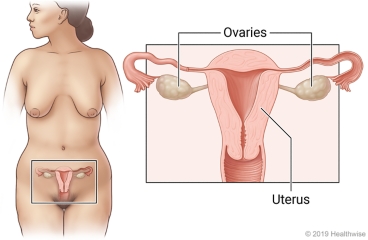
Your Recovery
Laparoscopic oophorectomy is surgery to remove one, both, or part of your ovaries. Your doctor put a lighted tube (scope) and other tools through small cuts in your belly to do this.
After surgery, you may feel some pain in your belly for a few days. Your belly may also be swollen. You may have a change in your bowel movements for a few days.
You may also have shoulder pain for a day or two. This is caused by the air your doctor put in your belly to help see your organs better.
To help with pain, your doctor may prescribe medicines. You may need about 1 week to fully recover. Avoid strenuous activity and lifting anything heavy while you recover. You can ask your doctor when it's okay to have sex.
If you had both ovaries removed, you will start menopause if you haven't already. Your doctor may prescribe you hormone therapy.
This care sheet gives you a general idea about how long it will take for you to recover. But each person recovers at a different pace. Follow the steps below to get better as quickly as possible.
How can you care for yourself at home?
 Activity
Activity
- Rest when you feel tired.
- Be active. Walking is a good choice.
- Allow your body to heal. Don't move quickly or lift anything heavy until you are feeling better.
- Hold a pillow over your incisions when you cough or take deep breaths. This will support your belly and may help to decrease your pain.
- Do breathing exercises at home as instructed by your doctor. This will help prevent pneumonia.
- Ask your doctor when it is okay for you to have sex.
 Diet
Diet
- You can eat your normal diet. If your stomach is upset, try bland, low-fat foods like plain rice, broiled chicken, toast, and yogurt.
- Drink plenty of fluids (unless your doctor tells you not to).
- If your bowel movements are not regular right after surgery, try to avoid constipation and straining. Drink plenty of water. Your doctor may suggest fiber, a stool softener, or a mild laxative.
 Medicines
Medicines
- Your doctor will tell you if and when you can restart your medicines. The doctor will also give you instructions about taking any new medicines.
- If you stopped taking aspirin or some other blood thinner, your doctor will tell you when to start taking it again.
- Be safe with medicines. Read and follow all instructions on the label.
- If you are not taking a prescription pain medicine, ask your doctor if you can take an over-the-counter medicine.
- If the doctor gave you a prescription medicine for pain, take it as prescribed.
- Store your prescription pain medicines where no one else can get to them. When you are done using them, dispose of them quickly and safely. Your local pharmacy or hospital may have a drop-off site.
 Incision care
Incision care
- If you have strips of tape on the cut (incision) the doctor made, leave the tape on for a week or until it falls off.
- Wash the area daily with warm, soapy water, and pat it dry. Don't use hydrogen peroxide or alcohol. They can slow healing.
- You may cover the area with a gauze bandage if it oozes fluid or rubs against clothing.
- Change the bandage every day.
- Keep the area clean and dry.
 Other instructions
Other instructions
- Wear loose, comfortable clothing. For a few weeks, avoid anything that puts pressure on your belly.
- You may want to use a heating pad on your belly to help with pain.
Follow-up care is a key part of your treatment and safety. Be sure to make and go to all appointments, and call your doctor if you are having problems. It's also a good idea to know your test results and keep a list of the medicines you take.
When should you call for help?
Call 911 anytime you think you may need emergency care. For example, call if:
- You passed out (lost consciousness).
- You have chest pain, are short of breath, or cough up blood.
Call your doctor now or seek immediate medical care if:
- You have pain that does not get better after you take pain medicine.
- You cannot pass stools or gas.
- You have vaginal discharge that has increased in amount or smells bad.
- You are sick to your stomach or cannot drink fluids.
- You have loose stitches, or your incision comes open.
- Bright red blood has soaked through the bandage over your incision.
- You have signs of infection, such as:
- Increased pain, swelling, warmth, or redness.
- Red streaks leading from the incision.
- Pus draining from the incision.
- A fever.
- You have severe vaginal bleeding. This means that you are soaking through your usual pads every hour for 2 or more hours.
- You have signs of a blood clot in your leg (called a deep vein thrombosis), such as:
- Pain in your calf, back of the knee, thigh, or groin.
- Redness and swelling in your leg.
Watch closely for changes in your health, and be sure to contact your doctor if you have any problems.
Where can you learn more?
Go to http://www.healthwise.net/patientEd
Enter L619 in the search box to learn more about "Laparoscopic Oophorectomy: What to Expect at Home".
Current as of: May 5, 2025
Author: Ignite Healthwise, LLC Staff
Clinical Review Board
All Ignite Healthwise, LLC education is reviewed by a team that includes physicians, nurses, advanced practitioners, registered dieticians, and other healthcare professionals.

